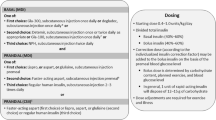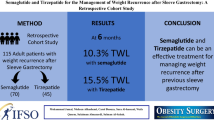Abstract
Background
Laparoscopic adjustable gastric banding (LAGB) provides weight loss in obese individuals and is associated with improved glucose homeostasis and resolution of type 2 diabetes. However, in most available reports, potentially inappropriate methodology has been applied when measuring the impact of LAGB on glucose intolerance. In order to clarify the applicability of the diagnostic 75 g-oral glucose tolerance test (OGTT) to measure the effect of LAGB on glucose metabolism, we investigated the effect of LAGB on gastric emptying for liquids as well as pancreatic and incretin hormone responses.
Methods
Eight obese patients (three with normal glucose tolerance, three with impaired glucose tolerance, and two with type 2 diabetes; age 47.5 ± 1.1 years (mean±SEM); body mass index 44 ± 1 kg/m2; HbA1c 6.2 ± 0.4%) underwent a 75 g-oral glucose tolerance test with 1 g acetaminophen before and ~6 weeks after LAGB.
Results
A small weight reduction was seen after LAGB (125 ± 8 vs. 121 ± 8 kg, P = 0.014). No differences in determinants of gastric emptying were observed before and after LAGB (area under the serum acetaminophen curve 10.1 ± 0.6 vs. 9.8 ± 0.5 mM×4 h, P = 0.8; peak acetaminophen concentration 62 ± 3 vs. 61 ± 3 μM, P = 0.8; acetaminophen peak time 98 ± 6 vs. 100 ± 6 min, P = 0.9). No differences in plasma glucose, insulin, C-peptide, glucagon, glucose-dependent insulinotropic polypeptide, or glucagon-like peptide-1 responses to the OGTT were observed before as compared to after LAGB.
Conclusions
OGTT can be used to evaluate glucose tolerance in obese patients before and after LAGB without bias from changes in gastric emptying. LAGB has no direct impact on incretin hormone secretion.



Similar content being viewed by others
Abbreviations
- AUC:
-
Area under curve
- BMI:
-
Body mass index
- FPG:
-
Fasting plasma glucose
- GIP:
-
Glucose-dependent insulinotropic polypeptide
- GLP-1:
-
Glucagon-like peptide-1
- HbA1c:
-
Glycated hemoglobin A1c
- HOMA:
-
The homeostatic model assessment
- HOMAIR :
-
Insulin resistance according to HOMA
- IGT:
-
Impaired glucose tolerance
- LAGB:
-
Laparoscopic adjustable gastric banding
- OGTT:
-
Oral glucose tolerance test
- SEM:
-
Standard error of the mean
- WHO:
-
World Health Organization
References
Wild S, Roglic G, Green A, Sicree R, King H. Global prevalence of diabetes: estimates for the year 2000 and projections for 2030. Diab Care. 2004;27(5):1047–53.
Intensive blood-glucose control with sulphonylureas or insulin compared with conventional treatment and risk of complications in patients with type 2 diabetes (UKPDS 33). UK Prospective Diabetes Study (UKPDS) Group. Lancet. 1998;352(9131):837–53.
Eriksson KF, Lindgarde F. Prevention of type 2 (non-insulin-dependent) diabetes mellitus by diet and physical exercise. The 6-year Malmo feasibility study. Diabetologia. 1991;34(12):891–8.
Stunkard AJ. Conservative treatments for obesity. Am J Clin Nutr. 1987;45(5 Suppl):1142–54.
Buchwald H, Avidor Y, Braunwald E, et al. Bariatric surgery: a systematic review and meta-analysis. JAMA. 2004;292(14):1724–37.
Dixon JB, O'Brien PE. Health outcomes of severely obese type 2 diabetic subjects 1 year after laparoscopic adjustable gastric banding. Diab Care. 2002;25(2):358–63.
American Diabetes Association. Standards of medical care in diabetes—2009. Diabetes Care. 2009;32 Suppl 1:S13–61.
Greenway SE, Greenway 3rd FL, Klein S. Effects of obesity surgery on non-insulin-dependent diabetes mellitus. Arch Surg. 2002;137(10):1109–17.
Tiktinsky E, Lantsberg L, Lantsberg S, et al. Gastric emptying of semisolids and pouch motility following laparoscopic adjustable gastric banding. Obes Surg. 2009;19(9):1270–3.
Willems M, Quartero AO, Numans ME. How useful is paracetamol absorption as a marker of gastric emptying? A systematic literature study. Dig Dis Sci. 2001;46(10):2256–62.
Holst JJ. On the physiology of GIP and GLP-1. Horm Metab Res. 2004;36(11–12):747–54.
Chaikomin R, Doran S, Jones KL, et al. Initially more rapid small intestinal glucose delivery increases plasma insulin, GIP, and GLP-1 but does not improve overall glycemia in healthy subjects. Am J Physiol Endocrinol Metab. 2005;289(3):E504–7.
Schirra J, Katschinski M, Weidmann C, et al. Gastric emptying and release of incretin hormones after glucose ingestion in humans. J Clin Invest. 1996;97(1):92–103.
Bablok W, Passing H, Bender R, Schneider B. A general regression procedure for method transformation. Application of linear regression procedures for method comparison studies in clinical chemistry, part III. J Clin Chem Clin Biochem. 1988;26(11):783–90.
Ørskov C, Jeppesen J, Madsbad S, Holst JJ. Proglucagon products in plasma of noninsulin-dependent diabetics and nondiabetic controls in the fasting state and after oral glucose and intravenous arginine. J Clin Invest. 1991;87(2):415–23.
Krarup T, Holst JJ. The heterogeneity of gastric inhibitory polypeptide in porcine and human gastrointestinal mucosa evaluated with five different antisera. Regul Pept. 1984;9(1–2):35–46.
Heading RC, Nimmo J, Prescott LF, Tothill P. The dependence of paracetamol absorption on the rate of gastric emptying. Br J Pharmacol. 1973;47(2):415–21.
Matthews DR, Hosker JP, Rudenski AS, Naylor BA, Treacher DF, Turner RC. Homeostasis model assessment: insulin resistance and beta-cell function from fasting plasma glucose and insulin concentrations in man. Diabetologia. 1985;28(7):412–9.
Matsuda M, DeFronzo RA. Insulin sensitivity indices obtained from oral glucose tolerance testing: comparison with the euglycemic insulin clamp. Diab Care. 1999;22(9):1462–70.
Wareham NJ, Phillips DI, Byrne CD, Hales CN. The 30 minute insulin incremental response in an oral glucose tolerance test as a measure of insulin secretion. Diabet Med. 1995;12(10):931.
Kosaka K, Kuzuya T, Hagura R, Yoshinaga H. Insulin response to oral glucose load is consistently decreased in established non-insulin-dependent diabetes mellitus: the usefulness of decreased early insulin response as a predictor of non-insulin-dependent diabetes mellitus. Diabet Med. 1996;13(9 Suppl 6):S109–19.
Kadowaki T, Miyake Y, Hagura R, et al. Risk factors for worsening to diabetes in subjects with impaired glucose tolerance. Diabetologia. 1984;26(1):44–9.
Chapman AE, Kiroff G, Game P, et al. Laparoscopic adjustable gastric banding in the treatment of obesity: a systematic literature review. Surgery. 2004;135(3):326–51.
Cunneen SA. Review of meta-analytic comparisons of bariatric surgery with a focus on laparoscopic adjustable gastric banding. Surg Obes Relat Dis. 2008;4(3 Suppl):S47–55.
Maggard MA, Shugarman LR, Suttorp M, et al. Meta-analysis: surgical treatment of obesity. Ann Intern Med. 2005;142(7):547–59.
Buse JB, Caprio S, Cefalu WT, et al. How do we define cure of diabetes? Diab Care. 2009;32(11):2133–5.
Hanusch-Enserer U, Ghatei MA, Cauza E, Bloom SR, Prager R, Roden M. Relation of fasting plasma peptide YY to glucose metabolism and cardiovascular risk factors after restrictive bariatric surgery. Wien Klin Wochenschr. 2007;119(9–10):291–6.
Pontiroli AE, Folli F, Paganelli M, et al. Laparoscopic gastric banding prevents type 2 diabetes and arterial hypertension and induces their remission in morbid obesity: a 4-year case-controlled study. Diab Care. 2005;28(11):2703–9.
Pontiroli AE, Gniuli D, Mingrone G. Early effects of gastric banding (LGB) and of biliopancreatic diversion (BPD) on insulin sensitivity and on glucose and insulin response after OGTT. Obes Surg. 2010;20(4):474–9.
Parkman HP, Harris AD, Krevsky B, Urbain JL, Maurer AH, Fisher RS. Gastroduodenal motility and dysmotility: an update on techniques available for evaluation. Am J Gastroenterol. 1995;90(6):869–92.
Vantrappen G. Methods to study gastric emptying. Dig Dis Sci. 1994;39(12 Suppl):91S–4S.
de Jong JR, Besselink MG, van Ramshorst B, Gooszen HG, Smout AJ. Effects of adjustable gastric banding on gastroesophageal reflux and esophageal motility: a systematic review. Obes Rev. 2010;11(4):297–305.
Hladik P, Vizda J, Mala E, Zadak Z, Hroch T. The contribution of gastric emptying scintigraphy to the treatment of obesity with gastric bandage—preliminary results. Biomed Pap Med Fac Univ Palacky Olomouc Czech Repub. 2008;152(1):125–8.
Horowitz M, Collins PJ, Harding PE, Shearman DJ. Abnormalities of gastric emptying in obese patients. Gastroenterology. 1983;85(4):983–5.
Wright RA, Krinsky S, Fleeman C, Trujillo J, Teague E. Gastric emptying and obesity. Gastroenterology. 1983;84(4):747–51.
Bertin E, Schneider N, Abdelli N, et al. Gastric emptying is accelerated in obese type 2 diabetic patients without autonomic neuropathy. Diab Metab. 2001;27(3):357–64.
Pacini G, Mari A. Methods for clinical assessment of insulin sensitivity and beta-cell function. Best Pract Res Clin Endocrinol Metab. 2003;17(3):305–22.
Nauck MA, Homberger E, Siegel EG, et al. Incretin effects of increasing glucose loads in man calculated from venous insulin and C-peptide responses. J Clin Endocrinol Metab. 1986;63(2):492–8.
Vilsbøll T, Krarup T, Madsbad S, Holst JJ. Both GLP-1 and GIP are insulinotropic at basal and postprandial glucose levels and contribute nearly equally to the incretin effect of a meal in healthy subjects. Regul Pept. 2003;114(2–3):115–21.
Flint A, Raben A, Astrup A, Holst JJ. Glucagon-like peptide 1 promotes satiety and suppresses energy intake in humans. J Clin Invest. 1998;101(3):515–20.
Le Roux CW, Welbourn R, Werling M, et al. Gut hormones as mediators of appetite and weight loss after Roux-en-Y gastric bypass. Ann Surg. 2007;246(5):780–5.
Bose M, Machineni S, Olivan B, et al. Superior appetite hormone profile after equivalent weight loss by gastric bypass compared to gastric banding. Obesity (Silver Spring). 2010;18(6):1085–91.
Korner J, Inabnet W, Febres G, et al. Prospective study of gut hormone and metabolic changes after adjustable gastric banding and Roux-en-Y gastric bypass. Int J Obes (Lond). 2009;33(7):786–95.
Acknowledgments
We thank all participants for spending time on this project and we are grateful for the technical assistance of Helle Lethmer, Lisbeth Andreasen, Marlene Rohr, Sofie Pilgaard, and Lene Albæk. This work was made possible by an EFSD/Novartis research grant.
Conflict of Interest
The authors declare that they have no conflict of interest.
Author information
Authors and Affiliations
Corresponding author
Additional information
Lotte Usinger and Katrine B. Hansen contributed equally to the present work.
Rights and permissions
About this article
Cite this article
Usinger, L., Hansen, K.B., Kristiansen, V.B. et al. Gastric Emptying of Orally Administered Glucose Solutions and Incretin Hormone Responses Are Unaffected by Laparoscopic Adjustable Gastric Banding. OBES SURG 21, 625–632 (2011). https://doi.org/10.1007/s11695-011-0362-9
Published:
Issue Date:
DOI: https://doi.org/10.1007/s11695-011-0362-9




